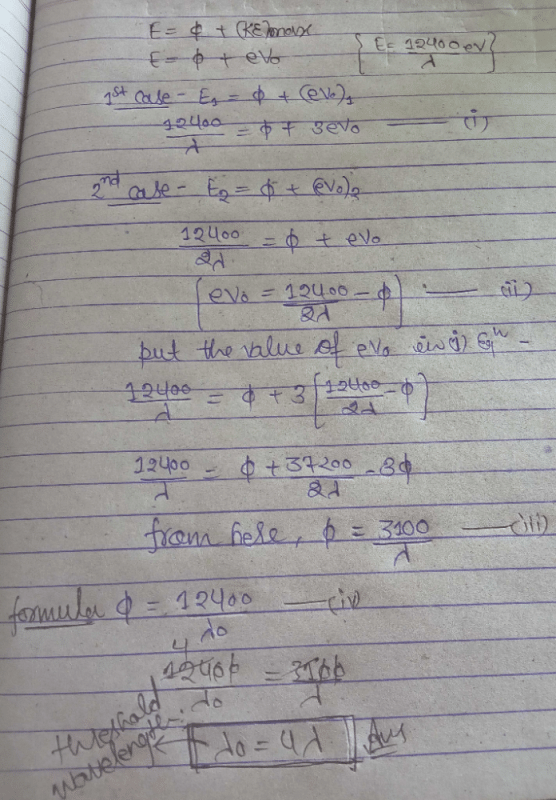NEET Exam > NEET Questions > When a metallic surface is illuminated by a m...
Start Learning for Free
When a metallic surface is illuminated by a monochromatic light of wavelength λ, then the potential difference required to stop the ejection of electrons is 3V₀. When the same surface is illuminated by the light of wavelength 2λ, then the potential difference required to stop the ejection of electrons is V₀. Then for photoelectric effect, the threshold wavelength for the metal surface will be
- a)6λ
- b)4λ/3
- c)4λ
- d)8λ
Correct answer is option 'C'. Can you explain this answer?
| FREE This question is part of | Download PDF Attempt this Test |
Most Upvoted Answer
When a metallic surface is illuminated by a monochromatic light of wav...

Free Test
FREE
| Start Free Test |
Community Answer
When a metallic surface is illuminated by a monochromatic light of wav...
Λ, the surface appears colored because of the phenomenon known as interference.
Interference occurs when two or more waves of the same wavelength superpose (combine) with each other. In the case of a metallic surface, the incident light wave reflects off the surface and interacts with the other waves that are already present on the surface. This interaction causes constructive or destructive interference, which affects the intensity (brightness) of the reflected light.
When constructive interference occurs, the waves combine to form a stronger wave, resulting in a brighter spot on the surface. Conversely, when destructive interference occurs, the waves cancel each other out, resulting in a darker spot on the surface.
The specific colors observed on the metallic surface depend on the wavelength of the incident light and the properties of the surface. Different metallic surfaces have different reflectance properties, meaning they reflect different wavelengths of light more strongly than others. This selectivity in reflectance leads to certain colors being more prominent on the surface.
For example, if the incident light has a wavelength of λ and the metallic surface preferentially reflects light of wavelength 2λ, then constructive interference will occur for that wavelength, resulting in a bright spot of that color on the surface. Other wavelengths may experience destructive interference, leading to darker spots or no reflection at all.
In summary, the color observed on a metallic surface when illuminated by monochromatic light depends on the interference between the incident light and the waves already present on the surface. This interference can result in constructive or destructive interference, leading to different intensities of reflected light and the perception of different colors.
Interference occurs when two or more waves of the same wavelength superpose (combine) with each other. In the case of a metallic surface, the incident light wave reflects off the surface and interacts with the other waves that are already present on the surface. This interaction causes constructive or destructive interference, which affects the intensity (brightness) of the reflected light.
When constructive interference occurs, the waves combine to form a stronger wave, resulting in a brighter spot on the surface. Conversely, when destructive interference occurs, the waves cancel each other out, resulting in a darker spot on the surface.
The specific colors observed on the metallic surface depend on the wavelength of the incident light and the properties of the surface. Different metallic surfaces have different reflectance properties, meaning they reflect different wavelengths of light more strongly than others. This selectivity in reflectance leads to certain colors being more prominent on the surface.
For example, if the incident light has a wavelength of λ and the metallic surface preferentially reflects light of wavelength 2λ, then constructive interference will occur for that wavelength, resulting in a bright spot of that color on the surface. Other wavelengths may experience destructive interference, leading to darker spots or no reflection at all.
In summary, the color observed on a metallic surface when illuminated by monochromatic light depends on the interference between the incident light and the waves already present on the surface. This interference can result in constructive or destructive interference, leading to different intensities of reflected light and the perception of different colors.
Attention NEET Students!
To make sure you are not studying endlessly, EduRev has designed NEET study material, with Structured Courses, Videos, & Test Series. Plus get personalized analysis, doubt solving and improvement plans to achieve a great score in NEET.

|
Explore Courses for NEET exam
|

|
Similar NEET Doubts
When a metallic surface is illuminated by a monochromatic light of wavelength λ, then the potential difference required to stop the ejection of electrons is 3V₀. When the same surface is illuminated by the light of wavelength 2λ, then the potential difference required to stop the ejection of electrons is V₀. Then for photoelectric effect, the threshold wavelength for the metal surface will bea)6λb)4λ/3c)4λd)8λCorrect answer is option 'C'. Can you explain this answer?
Question Description
When a metallic surface is illuminated by a monochromatic light of wavelength λ, then the potential difference required to stop the ejection of electrons is 3V₀. When the same surface is illuminated by the light of wavelength 2λ, then the potential difference required to stop the ejection of electrons is V₀. Then for photoelectric effect, the threshold wavelength for the metal surface will bea)6λb)4λ/3c)4λd)8λCorrect answer is option 'C'. Can you explain this answer? for NEET 2024 is part of NEET preparation. The Question and answers have been prepared according to the NEET exam syllabus. Information about When a metallic surface is illuminated by a monochromatic light of wavelength λ, then the potential difference required to stop the ejection of electrons is 3V₀. When the same surface is illuminated by the light of wavelength 2λ, then the potential difference required to stop the ejection of electrons is V₀. Then for photoelectric effect, the threshold wavelength for the metal surface will bea)6λb)4λ/3c)4λd)8λCorrect answer is option 'C'. Can you explain this answer? covers all topics & solutions for NEET 2024 Exam. Find important definitions, questions, meanings, examples, exercises and tests below for When a metallic surface is illuminated by a monochromatic light of wavelength λ, then the potential difference required to stop the ejection of electrons is 3V₀. When the same surface is illuminated by the light of wavelength 2λ, then the potential difference required to stop the ejection of electrons is V₀. Then for photoelectric effect, the threshold wavelength for the metal surface will bea)6λb)4λ/3c)4λd)8λCorrect answer is option 'C'. Can you explain this answer?.
When a metallic surface is illuminated by a monochromatic light of wavelength λ, then the potential difference required to stop the ejection of electrons is 3V₀. When the same surface is illuminated by the light of wavelength 2λ, then the potential difference required to stop the ejection of electrons is V₀. Then for photoelectric effect, the threshold wavelength for the metal surface will bea)6λb)4λ/3c)4λd)8λCorrect answer is option 'C'. Can you explain this answer? for NEET 2024 is part of NEET preparation. The Question and answers have been prepared according to the NEET exam syllabus. Information about When a metallic surface is illuminated by a monochromatic light of wavelength λ, then the potential difference required to stop the ejection of electrons is 3V₀. When the same surface is illuminated by the light of wavelength 2λ, then the potential difference required to stop the ejection of electrons is V₀. Then for photoelectric effect, the threshold wavelength for the metal surface will bea)6λb)4λ/3c)4λd)8λCorrect answer is option 'C'. Can you explain this answer? covers all topics & solutions for NEET 2024 Exam. Find important definitions, questions, meanings, examples, exercises and tests below for When a metallic surface is illuminated by a monochromatic light of wavelength λ, then the potential difference required to stop the ejection of electrons is 3V₀. When the same surface is illuminated by the light of wavelength 2λ, then the potential difference required to stop the ejection of electrons is V₀. Then for photoelectric effect, the threshold wavelength for the metal surface will bea)6λb)4λ/3c)4λd)8λCorrect answer is option 'C'. Can you explain this answer?.
Solutions for When a metallic surface is illuminated by a monochromatic light of wavelength λ, then the potential difference required to stop the ejection of electrons is 3V₀. When the same surface is illuminated by the light of wavelength 2λ, then the potential difference required to stop the ejection of electrons is V₀. Then for photoelectric effect, the threshold wavelength for the metal surface will bea)6λb)4λ/3c)4λd)8λCorrect answer is option 'C'. Can you explain this answer? in English & in Hindi are available as part of our courses for NEET.
Download more important topics, notes, lectures and mock test series for NEET Exam by signing up for free.
Here you can find the meaning of When a metallic surface is illuminated by a monochromatic light of wavelength λ, then the potential difference required to stop the ejection of electrons is 3V₀. When the same surface is illuminated by the light of wavelength 2λ, then the potential difference required to stop the ejection of electrons is V₀. Then for photoelectric effect, the threshold wavelength for the metal surface will bea)6λb)4λ/3c)4λd)8λCorrect answer is option 'C'. Can you explain this answer? defined & explained in the simplest way possible. Besides giving the explanation of
When a metallic surface is illuminated by a monochromatic light of wavelength λ, then the potential difference required to stop the ejection of electrons is 3V₀. When the same surface is illuminated by the light of wavelength 2λ, then the potential difference required to stop the ejection of electrons is V₀. Then for photoelectric effect, the threshold wavelength for the metal surface will bea)6λb)4λ/3c)4λd)8λCorrect answer is option 'C'. Can you explain this answer?, a detailed solution for When a metallic surface is illuminated by a monochromatic light of wavelength λ, then the potential difference required to stop the ejection of electrons is 3V₀. When the same surface is illuminated by the light of wavelength 2λ, then the potential difference required to stop the ejection of electrons is V₀. Then for photoelectric effect, the threshold wavelength for the metal surface will bea)6λb)4λ/3c)4λd)8λCorrect answer is option 'C'. Can you explain this answer? has been provided alongside types of When a metallic surface is illuminated by a monochromatic light of wavelength λ, then the potential difference required to stop the ejection of electrons is 3V₀. When the same surface is illuminated by the light of wavelength 2λ, then the potential difference required to stop the ejection of electrons is V₀. Then for photoelectric effect, the threshold wavelength for the metal surface will bea)6λb)4λ/3c)4λd)8λCorrect answer is option 'C'. Can you explain this answer? theory, EduRev gives you an
ample number of questions to practice When a metallic surface is illuminated by a monochromatic light of wavelength λ, then the potential difference required to stop the ejection of electrons is 3V₀. When the same surface is illuminated by the light of wavelength 2λ, then the potential difference required to stop the ejection of electrons is V₀. Then for photoelectric effect, the threshold wavelength for the metal surface will bea)6λb)4λ/3c)4λd)8λCorrect answer is option 'C'. Can you explain this answer? tests, examples and also practice NEET tests.

|
Explore Courses for NEET exam
|

|
Suggested Free Tests
Signup for Free!
Signup to see your scores go up within 7 days! Learn & Practice with 1000+ FREE Notes, Videos & Tests.
























